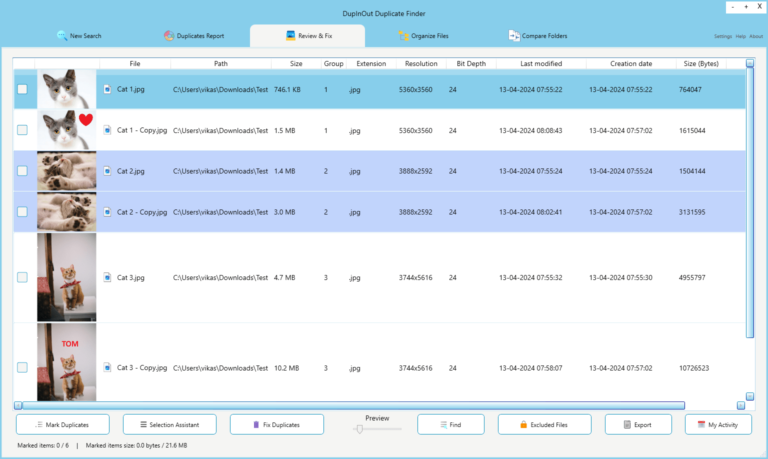
Duplicate Photos
Duplicate photos are identical copies of your images that may have been rotated, flipped, converted or minor edited. You may have acquired them from a variety of sources, either intentionally or unintentionally. If you don’t need these duplicate images, typically, it’s safe to delete them. A Duplicate Photo Finder software will help throughout the process.
Where Do I Get Duplicate Photos From?
Duplicates are accumulated through various ways — including through our regular activities. Knowing the exact source of duplication can help you tackle them in the future.
Imported Photos
These days, almost everyone has a smartphone. We all take photos from our phone and then transfer them to our PC. You may acquire a lot of duplicates while transferring photos from your smartphone or digital camera.
Repeated Downloads
We often download the same files over and again, and then forget to delete the identical copies. Over the years, we acquire a lot of duplicates.
Photo Editing
You may also acquire duplicates when you rotate, flip or minor edit a photo and then save it as another copy. This category of duplicates is called Similar Photos, which may not be 100% identical.
Photo Conversion Activities
When we convert an image to another format, the file conversion tool creates a new copy. Because each image format is unique in nature, both images may vary in terms of size, picture details, and quality.
Zip Archives
When you compress your photos, your program creates a Zip or similar file with your photos. As the original files remain intact, it results into duplication.
Duplicate Photo Finder
A Duplicate Photo Finder is a specialized utility that identifies both the exact-matching and visually-similar duplicate photos, and allows users to remove, move, rename or fix them in other ways. Its smart algorithms perform human-like photo comparison to simplify and shorten the process of finding duplicates.
A Duplicate Photo Finder provides additional options to fine-tune your scan to meet your personal needs. For example, you can choose a minimum level of similarity to determine which photos you want to flag as duplicates.
Duplicate Photo Finder Features
Here are some of the most popular features of the Duplicate Photo Finder for Windows 11:
Multiple Scan Modes
Whether you want to scan for visually-similar photos, duplicate music by music tags, or exact-matching duplicate documents, DupInOut Duplicate Finder supports each of these scan methods.
Adjust Similarity Threshold
Use the Similarity Threshold slider to determine the level of similarity between your photos. For example, when you select the 80% similarity level, photos with a minimum of 80% similarity are detected as duplicates.
Selection Assistant
Manually selecting each duplicate file can be a painful and time-consuming task. The Selection Assistant provides dozens of patterns to automatically mark or un-mark your files with one-click.
Save Session
The Save Session feature allows you to close the application without losing your scan results. It is also especially useful your scan is taking longer. You can choose to save the session and automatically shut down the computer after completion.
Advanced Duplicates Report
Shows a list of all folders containing your duplicate photos, with the number of duplicates in each folder. It can be helpful to know which folders acquire the most duplicates. You can also export this list to a CSV file.
Benefits of Using a Similar Photos Finder Software
Regularly deleting dupes can benefit you in various ways:
Free-up Storage
Are you running out of storage? If so, you can instantly free-up some storage by deleting identical files you may not need. You won’t have to delete your important files.
Easily Search Photos
Searching your photos, even if they were captured years ago, may become easier with a decluttered photo library. Deduplication makes your search results shorter and relevant.
Faster File Syncing
With fewer photos to sync, the file syncing process will become faster and bandwidth-friendly. You won’t have to wait for a long to finish syncing a long list of photos.
Photo Backups
Duplicate photos can increase the size of your backups. Backing up your photos may also take longer than usual. By deleting duplicates, the photo backups will be faster, and they will take less storage than before.
Differentiate Edited Photos
Do you frequently edit photos and then forget to delete the original versions? If so, a Duplicate Photo Finder will make it easier to identify the original and edited photos, and delete one of them which you don’t need.
How to Find Duplicate Photos on Your Computer?
Method 1: Using File Explorer
This method involves sorting photos in the ascending manner, and observing file name patterns to identify potential duplicates. It has its own pros and cons.
1. Open File Explorer.
2. Click on the Pictures folder on the left-side panel.
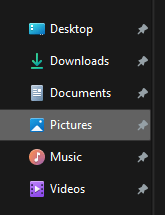
3. Right-click on an empty area.
4. Select Sort by > Name.
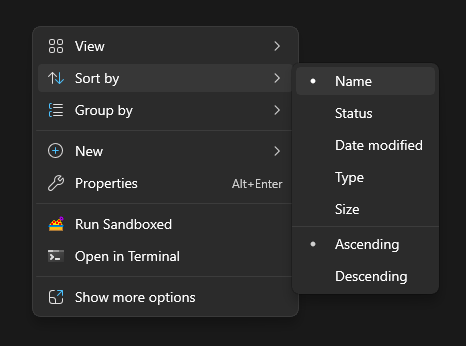
5. Your files will be sorted in ascending order.
6. Now review the files list to identify files with similar name patterns. For example, a duplicate version of “image1.jpg” may contain the file name “image1 – Copy(1).jpg”.
7. It’s highly recommended not to directly delete potential duplicate files. Move them to a separate folder so that you can restore any falsely flagged duplicates.
Method 2: Using a Duplicate Photo Finder Tool
This is the easiest method of finding duplicate photos. Not only does it save your time, but also reduce human errors.
1. Download DupInOut Duplicate Finder software.
2. Click on the Add button.
3. Select the folders or drives that contain your duplicate photos.
- C:\Users\<Your_User_Name>\Pictures
- C:\Users\<Your_User_Name>\OneDrive\Pictures
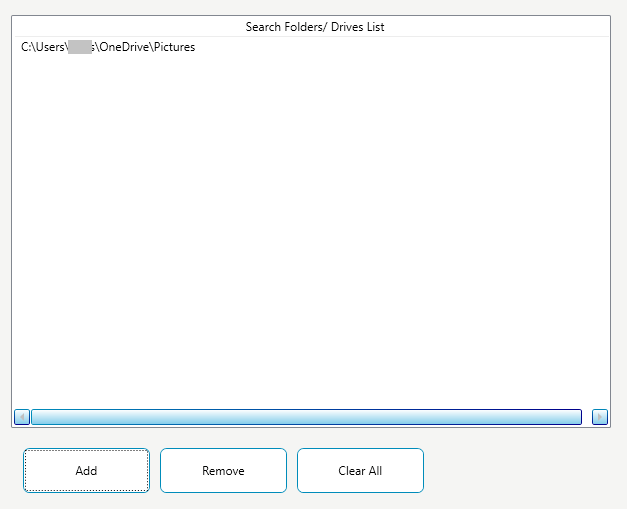
4. Set the Scan Mode to Similar Photos mode.
5. Choose your desired Similarity Threshold. (Move the “Similarity Level” slider to the left or right to adjust)

6. Click on Start Search.
7. Once the scan concludes, click on Review & Fix.
8. Use the Mark Duplicates button to automatically mark duplicate pictures in a pattern of your choice. Alternatively, you can manually mark or un-mark images manually.
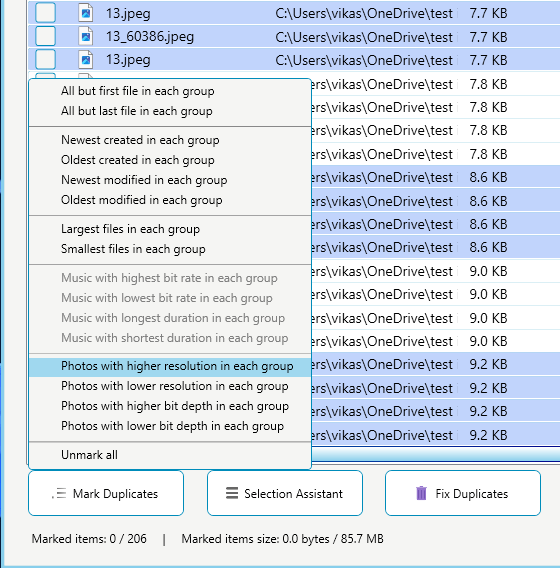
9. Click on Fix Duplicates, and choose one of the following options:
- Move to Folder
- Rename Files
- Replace with Shortcut
- Move to Recycle Bin
- Delete Permanently
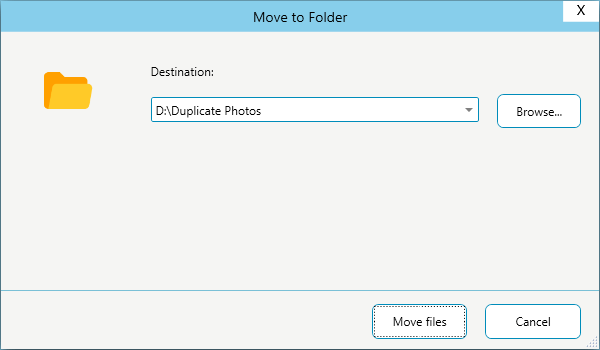
What are the Limitations of Manually Finding Duplicate Photos?
Manually finding duplicate photos is not a simple and straightforward process. Unlike documents and music, you may face multiple challenges while finding duplicate photos.
Scattered Files
Duplicate photos are often scattered across different folders and drives. It makes it difficult to manually find and compare them. If you have lots of data stored on your PC, it can add up to your stress.
Image Analysis
Manually analyzing the differences between photos is a tricky and time-consuming task. This is because your photos may vary in different aspects. They may be rotated or flipped. Or they may contain minor changes, such as a missing object.
File Name Patterns
Just because two photos share the same name, they need not be duplicates. Similarly, photos with different names can be duplicates. This is why, solely relying on the file name factor can lead to incorrect results and unexpected data losses.
Human Errors
Human errors are one of the major reasons behind data losses worldwide. Manually comparing hundreds of thousands of photos can lead to inaccuracies and data losses. It’s a good idea to take backups before deleting your files.
Confusion & Chaos
Over years, you may have acquired multiple versions of the same file. These versions may differ with each other, even though they are based on the same sources. Identifying such multiple variations of the same files, scanning for duplicate photos, can lead to confusion.
Frequently Asked Questions
How are Similar Photos Different from Same Photos?
Same Photos are 100% identical versions of your photos that match in every aspect — whether photo resolution, size or pixels. In contrast, Similar Photos are visually-similar copies that may differ in one aspect or another. For example, they can be minor edited, flipped or rotated versions of your original photos.
Which Similarity Level Should I Set?
The Similarity Threshold slider allows you to set the depth of the duplicate photo scan. To find the maximum number of duplicates, set the Similarity Threshold slider to the lowest value (70%). To find the closest matching duplicate photos, set the highest Similarity Threshold (90%).
Which Edited Photos Can Duplicate Images Finder Detect?
Duplicate Photos Finder tool can help you find a range of duplicate photos. It can find duplicate photos that have been rotated or cropped. It can also find photos that have been converted from one format to another. Besides, it supports finding photos that have been resized while keeping the original aspect ratio intact.
What are the Advantages of Automatically Finding Duplicates Over Manual Procedure?
The manual procedure of finding duplicate photos is prone to errors. Moreover, it can be a complex and time-consuming depending on the size of your collection. On the other hand, a Duplicate Image Finder software uses the modern technology to detect your photos, and provides you the flexibility to choose your preferred Similarity Level.